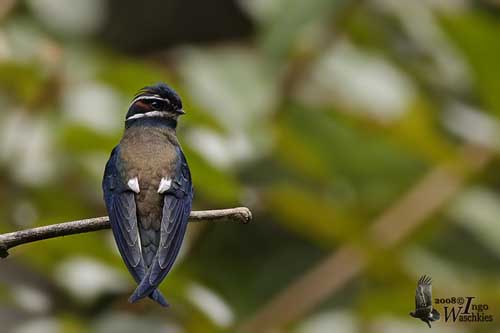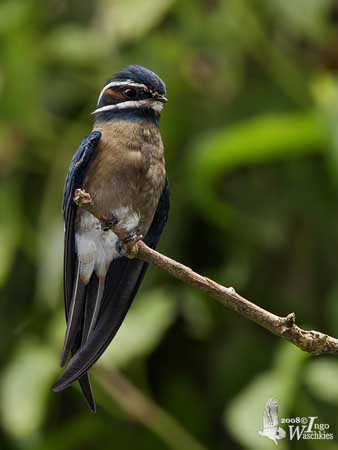
Fr: Hémiprocné coiffé
All : Ohrenbaumsegler
Esp : Vencejo Arborícola Chico
Ital: Rondone arboricolo minore
Nd: Kleine Boomgierzwaluw
Sd: Mindre trädseglare
Photographer:
Ingo Waschkies
My bird pictures on Pbase
Text by Nicole Bouglouan
Sources:
HANDBOOK OF THE BIRDS OF THE WORLD Vol 5 by Josep del Hoyo-Andrew Elliott-Jordi Sargatal - Lynx Edicions - ISBN: 8487334253
L’ENCYCLOPEDIE MONDIALE DES OISEAUX - Dr Christopher M. Perrins - BORDAS - ISBN: 2040185607
BirdLife International (BirdLife International)
Wikipedia, the free encyclopaedia
Whiskered Treeswift
Hemiprocne comata
Apodiforme Order – Hemiprocnidae Family
BIOMETRICS:
Length: 15-17 cm
DESCRIPTION:
The Whiskered Treeswift is the smallest of this family. This bird could be an intermediate between the typical swifts with its habits and appearance, and the nightjars, regarding the short bill, the large mouth and the bristles which surround it, making easier to detect the flying preys.
The adult male has dark bronze-brown body with white belly, flanks and undertail-coverts. The long wings and the forked tail are deep blue, but the tertial flight feathers are white. The underwing shows blue coverts and white tertial flight feathers.
The head is blue to glossy black, and slightly crested. We can see two conspicuous white parallel stripes formed by bold supercilium from forehead to hind nape, and a second stripe from chin back to neck side. The contrast between these white lines and the dark head is strong.
The male shows dark chestnut ear-coverts.
The short bill is black. The large eyes are dark brown. The short legs and the feet are pale pinkish-brown.

The female is similar but she has deep blue-green ear-coverts.
The juvenile has finely barred brown, grey and white plumage. The facial stripes are shorter than in adults.
The other subspecies H.c. major has more white on belly and tertials, broader tail-streamers and shallower tail-fork.
VOICE: SOUNDS BY XENO-CANTO
The Whiskered Treeswift is quieter than the largest species of this family. The contact call between pair-members includes high-pitched “chew” or “kweeo”, and series of short notes “kwee kwee, kwi-kwi-kwi-kwi” or “she-she-she-SHEW-she”. These calls are uttered while the birds are flying or perched.
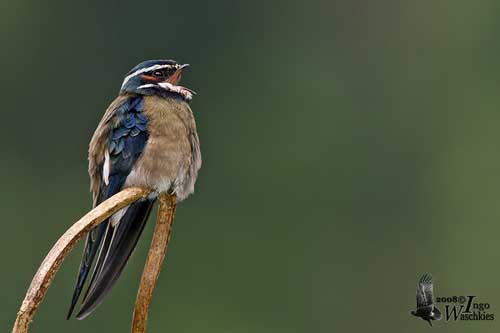
HABITAT:
The Whiskered Treeswift is a forest-living species which frequents small cover breaks such as tracks or streams, but it also follows the vegetation up around the highest emergent crowns in evergreen forest and locally in tall mangroves.
This species occurs from plains up to 1000-1100 metres on slopes, but it is often seen below 800 metres in N Malay Peninsula.
RANGE:
The Whiskered Treeswift is found in SW Asia, in Brunei, Indonesia, Malaysia, Myanmar, the Philippines, Singapore and Thailand.
BEHAVIOUR:
The Whiskered Treeswift feeds primarily on insects. It hunts from perches where it sits in upright posture, and from where it can have a good all-round vision of the surroundings.
Very agile in flight, it chases insects and small flying arthropods, even amongst the foliage but well below the canopy. The preys are usually taken on the wing, but it also picks off the food items when perched, or by hanging from the tip of a small branch. It may perform short sallies from its perch, close to the surface of the vegetation.
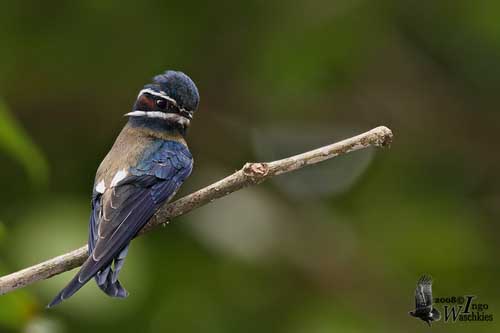
The courtship displays are poorly known, but noisy soaring has been reported at least for the largest species. Considering the head patter of the male, it probably enhances the white stripes and the chestnut patches of the ear-coverts by some adapted postures.
The breeding pair is territorial during the breeding season.
This species is sedentary. The breeding pair remains in its nesting territory all year round.
FLIGHT:
The Whiskered Treeswift is very agile and manoeuvrable in flight. The narrow, curved wings and the long tail streamers are very typical of fast fliers.
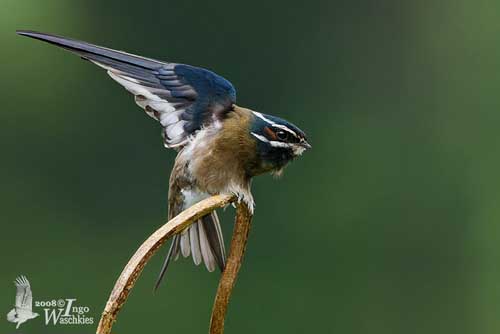
REPRODUCTION:
The breeding season occurs between February and August.
Both adults build the nest. This is a small half-saucer. The rim is made with saliva into which feathers are embedded, and some twigs too. Materials can be added during the incubation.
Such nest is very small, a shallow structure allowing only a single egg, standing right as in an egg-cup.
The very thin papery walls are unable to support an adult or a large chick. For this reason, the incubating adult squats on the branch instead on the nest itself. Only the belly touches the egg.
The nest is situated between 8 and 40 metres above the ground, on the upper surface of thin branch, and looks like a part of this branch.
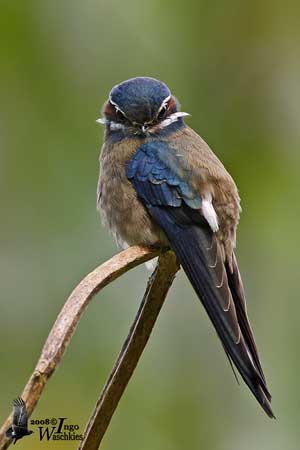
The female lays a single white egg. Both adults incubate and rear the chick. The incubation lasts about three weeks, but the chick leaves the nest very soon, within one week after hatching.
The chick is fed by regurgitation from adult’s throat into the open mouth, but later, the young takes the food from the parent’s mouth. The juvenile plumage is cryptic for better camouflage. It needs probably about 50 days for complete development.
DIET:
The Whiskered Treeswift feeds mainly on insects and small flying arthropods.
PROTECTION / THREATS / STATUS:
The Whiskered Treeswift is relatively common in most parts of the range. However, this species is threatened by habitat loss due to clearance and degradation of forest within the range, in spite of its ability to exploit new habitats.
The Whiskered Treeswift is evaluated as Least Concern by Birdlife International.
